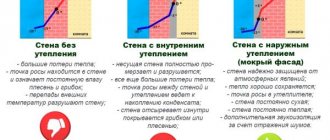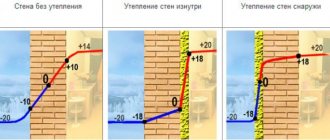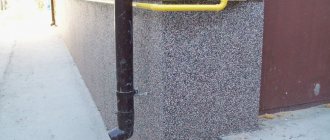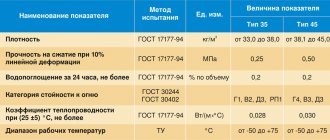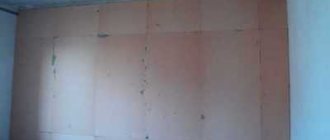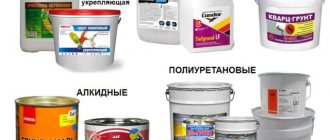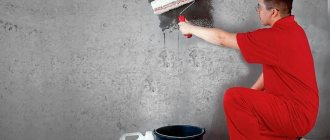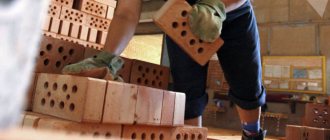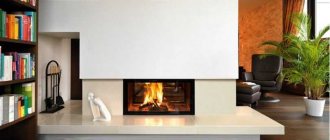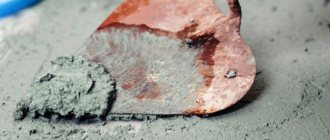Plastering walls is an old technique; it helps to create an even coating and gain additional protection from environmental influences. Plastering work can be performed not only in residential premises; the technique can also be applied to other types of buildings. For example, plastering the walls in a garage can make it more comfortable to stay in; the specifics of such work will be discussed in more detail below.
Why do you need to plaster the walls in the garage?
Plastering a garage is necessary to solve the following problems:
- leveling surfaces for decorative finishing;
- protecting the premises from dampness, maintaining a stable microclimate;
- increased thermal protection and noise insulation;
- protection of walls from mechanical damage;
- ensuring fire safety;
- increasing the durability of repairs;
- prevention of mold, mildew, etc.
Plastering is a budget-friendly, easy-to-perform, environmentally friendly way of decorating garage buildings. The plaster is repairable, durable, does not absorb odors, and can be applied manually or by machine.
Wood paneling
Perhaps this method of decorating garage walls is used even less frequently than tiles. Wood absorbs odors; in addition, it can be subject to combustion, which is completely unsafe. Especially in the context of the unpleasant situation that I described at the beginning of the article.
But if you still decide to use wood to cover the walls of the garage, it must first be treated with an antiseptic and anti-flammable substances. In addition, do not forget about using such a wonderful product as stain. It not only protects the wood, but also gives it an aesthetically attractive appearance. In general, it is a must use.
In the garage, you should not install wooden lining for interior decoration of country cottages, but a facade board or one that is intended for laying on the floor. Another, by the way, very correct way of finishing walls is OSB/plywood sheathing. This makes sense for several reasons:
- Firstly, practicality. You can attach various shelves, hooks to OSB boards to hold tools, and so on. In addition, if necessary, the shelf or hook can be moved to another place, while the hole at the old mounting location will be invisible. Agree, boards do not provide such an opportunity,
- secondly, the price of the issue. OSB will cost much less compared to boards,
- thirdly, ease of installation work. Screwing a large sheet to the frame with self-tapping screws is much easier than mounting each board separately.
How to plaster the walls in a garage with your own hands
Before plastering the garage, the appropriate type of composition is selected in accordance with the design project, climatic conditions of the area, etc.
According to their performance characteristics, plaster mixtures are divided into the following types:
- Universal
- can be used for interior and exterior decoration. The advantage of materials is strength, resistance to temperature changes, mechanical damage, and ultraviolet radiation.
- Facade
— plaster mixtures are characterized by increased resistance to environmental influences, withstand cold weather, and are resistant to ultraviolet radiation. The coatings are wear-resistant and durable.
- Not recommended for use in garages
plasters for interior decorationapartments, houses, because buildings can be unheated or partially heated.
According to their intended purpose, plaster compositions are divided into the following:
- standard
- used to eliminate defects and unevenness of the base;
- decorative
- used for finishing, giving an aesthetic appearance to the room;
- special
— the category includes heat-, hydro- and noise-insulating, sanitizing plasters.
For finishing garage buildings, experts recommend choosing mixtures with heat-protective and waterproofing properties, in addition to leveling and decorative properties.
Based on the type of binding component, materials are divided into the following types:
- cement;
- limestone;
- gypsum;
- clay;
- silicate;
- acrylic;
- silicone, etc.
Cement
You can plaster a garage with your own hands using a cement mixture. The material is highly durable, forms a dense base that hardens quickly. The binding component is Portland cement. The most popular compositions are cement-sand. The proportions of cement and river sand may differ depending on the purpose and be 1:1 or 1:4.5.
With a high concentration of cement powder, solutions can shrink during hardening, which leads to the appearance of cracks and chips. Therefore, the optimal proportions for a garage building are 1:3. To increase elasticity, plasticizers are added to the mixture. To prepare a cement-lime plaster composition, you will need to prepare sifted river sand, slaked lime and cement in a ratio of 7:2:1.
The advantages of cement plaster are as follows:
- high waterproof characteristics;
- durability of the coating;
- strength;
- the mixture is suitable for exterior and interior decoration;
- environmental friendliness of the composition;
- maintainability;
- resistance to temperature changes, frost resistance;
- fire safety;
- the solution can be mixed in large volumes;
- good compatibility with other binders;
- resistance to increased air humidity, etc.
It is necessary to take into account the low elasticity of the plaster mixture; the coating is not done in rooms with high vibration loads and earthquake-prone areas. To maintain the integrity of the treated surface, it will be necessary to moisten the walls covered with cement plaster for several days after work.
To improve smoothness, additional treatment of areas with putty compounds is recommended. In some cases, it is necessary to pre-level the base with primers.
The design of smooth walls and other surfaces often requires increasing adhesion and fixing plaster mesh (synthetic or steel) or installing beacons.
Plaster
Gypsum plaster is a classic composition for interior finishing work. In addition to gypsum, the mixture contains components that increase the performance characteristics of the material. For facade decoration of garages, gypsum-based compositions are not used due to low moisture resistance. The material can be used in garage buildings with heating or insulated roofing, waterproofing of floor coverings.
Gypsum plaster compositions are plastic, easy to apply, but harden quickly. Therefore, the solution is prepared in small portions. The advantage of gypsum mixtures is the absence of shrinkage, good vapor permeability, which allows you to maintain a stable microclimate in the room. The finish is aesthetically pleasing and does not require the additional use of putties to level the coating. The material dries quickly, allowing for quick repairs.
It is necessary to take into account the sensitivity of the composition to water ingress. Due to increased humidity in the room, gypsum plaster will peel off and lose its aesthetics.
The material is not recommended for finishing garage buildings that can withstand heavy mechanical loads, because The gypsum coating may crack.
Limestone
Lime plasters are used for interior and facade finishing of garages. The mixture is prepared on the basis of lime paste, suspension, etc. Lime is less durable than gypsum and cement powder. Therefore, plaster mortars are produced with additional components (cement-lime, gypsum-lime, etc.). Mixtures with the addition of cement (up to 20% in the composition) can be used for finishing facades. A solution of lime and sand in a ratio of 1:3 is in demand.
The advantages of lime-based plasters are as follows:
- high vapor permeability;
- good adhesion characteristics with different surfaces (brick, plasterboard, wood, finished with mineral agents);
- ease of application and leveling;
- maintainability;
- long shelf life;
- the antibacterial characteristics of the mixture prevent the appearance of fungus and mold;
- affordable price;
- high thermal insulation characteristics of the solution;
- resistance to temperature changes;
- elasticity of plaster, etc.
The list of shortcomings includes low strength, the need to add components to the solution that increase durability, and instability to vibrations. To increase the water resistance of the coating, you can perform protective finishing of external surfaces (roof, building facade) from precipitation.
The list of solutions popular for treating garages includes lime-clay, which is prepared from slaked lime, clay dough, and river sand in proportions 1:3:4. You can vary the volume of sand according to the fat content of the clay.
The lime-gypsum plaster mixture is prepared in the proportions of ingredients 1:3. Water is poured into the container, gypsum is added while stirring, then slaked lime is added.
Manufacturers produce ready-made plaster compositions with lime that can be used immediately.
Other modern materials for exterior and interior use
The list of popular formulations with synthetic substances includes:
- silicate;
- acrylic;
- silicone, etc.
Silicate plasters are characterized by high strength, resistance to alkaline chemicals, moisture, vapor permeability, fire resistance, good adhesion to various substrates, and can be used for decorating premises. The silicate coating is easy to clean, does not shrink after drying, and does not form cracks on the surfaces.
The material is suitable for treating porous areas (brick walls, gas silicate blocks), insulation. The disadvantages are high cost, instability to shrinkage and vibrations of the base.
Acrylic mixtures are characterized by high elasticity, good adhesion, resistance to detergents, water, a wide palette of shades, durability, strength, wear resistance, and vapor permeability. However, it is necessary to take into account the lack of fire resistance when used without special additives, and the rapid hardening of the solution.
Silicone plaster mixtures are characterized by high elasticity, good adhesion, and durability. The composition is based on silicone resins. The coating forms a polymer film that is difficult to clean off. At the same time, it allows air to pass through, preventing water from entering. The material is environmentally friendly, resistant to climatic precipitation, mechanical damage, and vibration. However, it has a high cost.
Price of plastering works
Despite the apparent simplicity of plastering processes, in reality it is a complex undertaking. Especially for those who have never done this. But there are a huge number of offers on the construction services market. Professional plasterers of various qualifications offer plastering of external and internal walls of garages in two to three days. At the same time, they offer a full range of services, including finishing and electrical installation work.
The price of plastering a garage varies depending on the size of the building, its number of floors and additional work. For example, garbage removal, screeding, painting, etc. The range is quite wide: from 250 to 700 rubles per square meter of surface. It is necessary to take into account that the costs themselves will depend on the thickness of the applied plaster layer. For example, plastering with a layer of 1.5 cm will require costs in the range of 20 liters of ready-made mortar. And if we convert this figure into ruble equivalent, then a significant amount will be needed.
It is clear that the thicker the layer of material applied, the greater the cost of plastering. Accordingly, the prices of the masters will be higher. Therefore, it is worth inviting good craftsmen who will build a garage. After all, the more evenly the bricks or blocks are laid, the smaller the difference in plane will be. This means that it will need to be covered with a thin layer of plaster. One comes out of the other and ends up in quality.
The price of plastering depends on the size of the garage and the thickness of the applied mortar Source th.decorexpro.com
Choosing the optimal plaster solution
Many people are interested in what is the best way to plaster the walls in the garage. There are mixtures for interior and exterior decoration. Materials differ in composition, technical characteristics, application rules, etc.
How to plaster the inside of a garage
The construction requires finishing of walls and ceilings. For the ceiling, plaster compositions that are easy to apply, gypsum, are recommended. Reinforced mixtures for ceilings are not used, because surfaces are not subject to force and abrasion. Walls will require high strength compounds that can withstand mechanical loads.
For the lower part of the walls, cement-sand plasters are used for leveling, and acrylic compounds are used as the finishing coating. These areas can be finished with waterproofing plaster materials. For garages located in areas with a dry climate, a cement-lime sand mixture can be used for the walls.
Plastering external walls
For facade finishing, specialized mixtures for external use or universal ones are recommended. For panels that can get wet, waterproofing plaster materials are selected. For garage buildings located in a region with a warm climate and low air humidity, a cement-lime sand mixture is used.
CEILING
The ceiling of the first floor is hemmed underneath with 12 mm thick OSB measuring 1250 * 2500 mm. There were 8 sheets in total. Between the floor beams and the OSB sheets, an Izospan vapor barrier with a thickness of 55 microns is laid. Then we will lay insulation boards between the beams on top.
For a doorway measuring 80 * 189 cm, I ordered a metal door of such a design that there was maximum passage. Since it is useless to drive pins into a four-slot sand-cement block, to fasten the door we ordered a frame 80 * 189 cm from a corner with a 50 mm shelf. The frame was installed from the inside and welded to the base of the door with several steel strips. Then the gaps between both frames were plastered. The lock is a cylindrical three-bolt lock. A valve was installed from the inside.
I ordered the window from the REHAU profile along with a low tide in, located nearby (Fryazino), so it cost me only 12,500 rubles. with delivery and installation. Dimensions – 90 * 105 cm. Double-glazed window, energy-saving (a thin layer of silver is applied to the first glass on the inside). Then they made slopes: from the outside perpendicular to the wall, from the inside - with an outward slope, excluding the horizontal area under the window sill.
Necessary tools and materials for plastering walls in the garage
In the list of tools:
- trowel or trowel;
- a set of spatulas of different sizes;
- brushes;
- building level;
- ladle;
- plumb line;
- roller;
- roulette;
- construction mixer;
- rule;
- grater;
- masking tape;
- pencil or marker.
The following materials will be required:
- primer;
- plaster composition, ready-made or in powder form;
- water (for mixing the solution), etc.
The list of additional tools includes self-tapping screws for fixing beacons or reinforcing mesh, construction cord, containers, and protective compounds.
Coating care
The plaster coating is unpretentious in maintenance. If the application took place during the hot period of the year, then to avoid cracking the surface must be moistened with water for three days, and small cracks must be rubbed with a trowel.
Regular care of a plastered wall involves removing dust and dirt using a vacuum cleaner or wet method.
Plaster is a popular finishing material, as it has many advantages and is relatively inexpensive. Doing plastering work with your own hands is quite possible and will help you save on paying workers.
Manual plastering technology for garages outside and inside
When performing work in a garage complex, the recommended temperature is about +5...+30°C, there should be no precipitation in the form of rain or snow (for exterior finishing). The required air humidity level is up to 60%.
Plastering work is carried out in the following sequence:
- surface preparation;
- inspection of walls, measurements of height differences, calculation of the volume of plaster, primer;
- installation of reinforcing mesh;
- installation of beacons;
- mixing the solution;
- plastering in several layers;
- dismantling beacons, filling grooves with a mixture;
- smoothing the coating;
- performing finishing work (applying decorative plaster, painting, etc.).
Surface preparation
Preparing the base for plastering is necessary to improve the adhesion characteristics with the material of the walls and floors in the garage.
Preliminary work includes the following steps:
- cleaning surfaces from dust, dirt, grease stains;
- removal of old fasteners;
- electrical wiring and remaining fastenings must be insulated with oil paint;
- Areas of walls damaged by mold and mildew are cleaned and disinfected using a biocide;
- cracks and chips are expanded, dust-free, filled with cement-sand mortar;
- large cracks need to be additionally reinforced with fiberglass reinforced mesh;
- to increase adhesion, smooth concrete surfaces should be treated with an ax or chisel to create notches, and walls lined with bricks should be treated with hard metal brushes;
- wooden bases must be covered with shingles;
- the base is primed and dried;
- electrical wiring is de-energized;
- sockets are covered with masking tape;
- You can protect the window frame and door frames with tape.
Reinforcing mesh
Plaster on garage walls will last longer when applied to a fixed reinforcing mesh. Coating is necessary when the planned thickness of the coating is large. The steel mesh is secured with dowels, which are evenly distributed over the surface. Fiberglass meshes are fixed to an adhesive base or plaster mortar.
Beacon device
Plastering along beacons allows you to eliminate unevenness and height differences on surfaces. Using the guides you can level the plaster mixture. Planks can be made from different materials (wood, plastic, metal alloys, clay mortar). Beacons are installed at intervals of 1-1.5 m, the symmetry of placement is checked with a stretched cord. Side profiles should be placed no more than 15-20 cm from the corners of the wall.
Splash
Leveling plaster is performed in 2-3 layers. The spray is applied first, which is necessary to increase the adhesion of the base to the finishing material. The solution for treatment is prepared with a creamy consistency. The material is sprayed using a ladle or trowel. Before spraying, the surface is moistened with water. The solution is poured without gaps. The upper part of the layer is not leveled. The subsequent material (primer) is applied after 24 hours.
Primer
The base layer of the leveling coating is made with a primer. The solution is prepared with a more viscous consistency. The mixture is applied to the walls with a spatula or trowel. After applying the composition to an area of about 1 m², you need to use the rule to level the mass using movements from bottom to top.
It is optimal to perform 2-3 passes with the tool. Then they continue to sequentially apply primer to the walls. Areas at joints and corners are treated last. After the solution has hardened, the beacon strips are removed. The grooves are filled with primer and leveled with a wide spatula.
Plastering and sanding
The final layer is a covering layer, which is necessary to prepare the walls and ceiling for painting. The solution should have a creamy consistency, with a component ratio of 1:1. The filler in the composition is fine sand. The coating is applied with a spatula in a thin layer and immediately rubbed over. After circular grouting, the surface is processed using straight-line movements of the trowel. Covering is carried out in 2 passes. After drying, the surfaces are sanded with fine-grained sandpaper.
No. 3. Drywall
Drywall has conquered not only residential premises, but also technical ones. So sheets of plasterboard are now often used to decorate garage walls. Naturally, only those that have additional protection from moisture and fire . You can recognize this material by its gray-green color, red markings and the name GKLVO.
Advantages:
- low cost ;
- light weight of the material , relatively simple and quick installation , absence of dirt, dust and debris during the installation process (not like plaster);
- thorough preparation of the base is not required - all holes, cracks and other defects will be hidden behind even and smooth sheets of drywall;
- when installing drywall on a frame, free space is created between the base and the sheets themselves, which can be used to place insulation ;
- fire and moisture resistance.
Flaws:
- when installing sheets on a frame, the area of the room will be reduced , so if the garage is small, carefully carry out the calculations and try to assess how the room will change after finishing. There is also an adhesive installation method, then the area of the room is not reduced, but the possibility of insulation disappears;
- the need for additional cladding , since the surface of the plasterboard is not very attractive, given the presence of seams. In addition, finishing will improve some of the performance qualities of the material;
- low impact resistance , but this disadvantage can be negated by using ceramic tiles as finishing - drywall will withstand such a load;
- to wash the surface of plasterboard from contaminants , so it is better to paint it with moisture-resistant washable paints - this is the simplest and most cost-effective option for finishing plasterboard walls.
Drywall in a garage can be used not only for finishing walls, but also for constructing partitions, as in apartments. If you need to allocate, for example, an area for a storage room or workshop, then you will only need to build a frame and cover it with sheets.
How to correctly calculate the mixture consumption on garage walls
To determine the required amount of plaster mixture, it is necessary to measure the walls after installing the beacons. Please note that the thickness of the coating may vary in different areas of the garage. The average layer thickness is calculated taking into account height differences. The indicator is multiplied by the area being processed.
It is also necessary to add 20% of the reserve to the total volume of plaster. Calculations can be performed using online calculators, which are offered on the websites of manufacturers of building and finishing materials.
Pros and cons of coverage
Like any finishing material, plaster has its own specific set of advantages and disadvantages.
The advantages include:
- The plaster is resistant to mechanical and weather influences.
- It has an almost unlimited shelf life.
- The plaster is environmentally friendly: it does not absorb dirt and odors, and does not emit toxic substances;
- The material has the property of moisture resistance. In addition to a comfortable microclimate inside the garage, this means, for example, that if you put a wet car in the room, it will dry faster.
- It is publicly available. You can buy plaster at any hardware store, choosing from a wide variety of colors and types.
The disadvantages include:
- Labor-intensive application – working with plaster can cause some difficulties.
- Difficult to dismantle. If you decide to remove the plaster layer, it may cause you a lot of inconvenience and will require a lot of effort and time.
Features of plastering an unheated garage
When plastering an unheated garage building, it is necessary to select materials with waterproof characteristics, because... Due to temperature changes, condensation will accumulate in the room. When using gypsum plaster, experts recommend covering the treated surfaces with hydrophobic paint. For durable repairs, it is better to use hydrophobic plasters. Work must only be carried out at suitable ambient temperatures.
Surface preparation
The durability of the finishing material largely depends on surface preparation. To ensure that the plaster does not swell over time and begin to crumble, you need to perform high-quality preparation. What does this training include?
The first thing you need to do is remove the old finish, this could be paint, whitewash, wood paneling and more. Next, you need to clean the surface from dirt and dust. To do this, you can use a regular spatula, which you can use to clean the surface from dirt. And with a brush you can clean the surface from dust.
After cleaning the walls, check the surface for cracks; if you find them, seal them with mortar, foam, or other substance that can seal the crack. After this, secure the iron mesh to the surface. It can be secured with dowels or self-tapping screws. Since there are temperature changes in the room, the reinforcing mesh can make the coating more stable and reliable.
Decorating the walls inside the garage
To decorate the walls, you can use original tiles, tool holders, boxes for storing items and various devices. It is optimal to paint a room with rich, harmonious tones; the space can be visually expanded by separating colors with contrasting horizontal stripes. The use of decorative plaster “world map”, “under a fur coat”, “bark beetle”, “mosaic”, etc. is universal.
